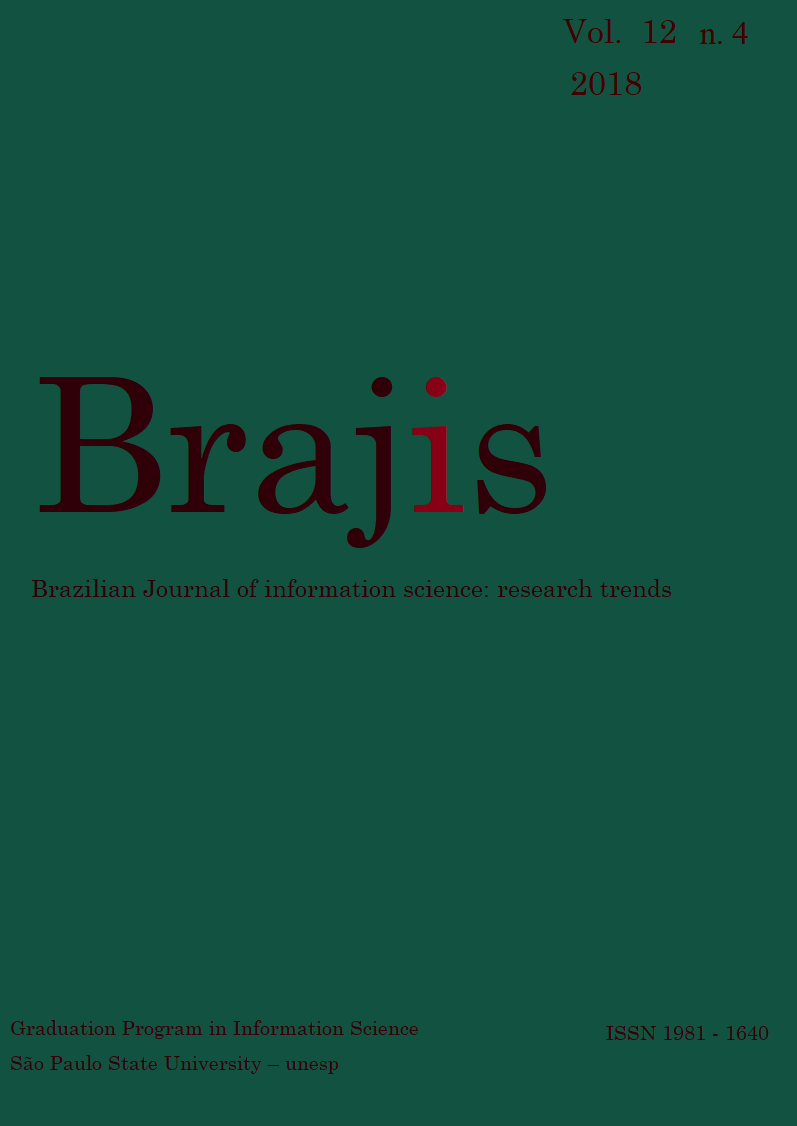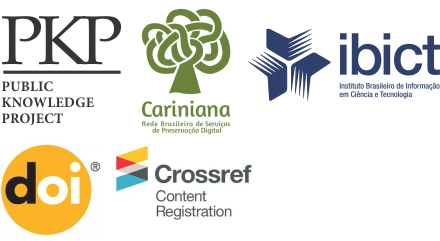A Computer model of information behavior to study information security professionals
DOI:
https://doi.org/10.36311/1981-1640.2018.v12n4.04.p22Palavras-chave:
Information behavior, ontologies, artificial intelligence, machine learning, predictive models, psychology, cognitive scienceResumo
In this paper, we propose a computer model of information behavior to study information security professionals and an architecture, which mimics the way our brain learns new concepts to simulate this behavior computationally. Used to represent and describe any domain of knowledge, we may use ontologies to study the human information behavior and show some of the concepts and relation-ships involved in this field of knowledge. A deep knowledge of the core concepts underpinning this field can provide us with a solid basis for constructing a model. We can also use computer-programming tools not only to capture the ideas that make up this field of knowledge, but can also simulate the human information behavior. The use of computers also allows us to crawl data over the Internet and process large amounts of them in order to find patterns with some specific characteristics. In the paper, we also present the current state of this research and challenges of the model.
Downloads
Métricas
Referências
Antoniou, G.; Harmelen, F. V. (2012). A semantic web primer. Cambridge, MA: MIT Press, 2012.
Alpayd?n, E. (2014). Introduction to machine learning. Cambridge, MA: MIT Press, 2014.
Ausubel, D. P. (2011). The acquisition and retention of knowledge: A cognitive view. Dordrecht: Springer, 2011.
Bates, M. (2005). An introduction to metatheories, theories, and models. // Fische, K.; Erdelez, S.; Mckechnie, L. (Orgs.). Theo-ries of information behavior. Medford: Information Today, 1-24.
Belkin, N. J. (1980). Anomalous states of knowledge as a basis for information retrieval. // Canadian Journal of Information Science 5 (1980) 133-143.
Buckland, M. K. (1991). Information and information systems. New York, NY: Praeger Publishers, 1991.
Byström, K., Ja?rvelin, K. (1995). Task complexity affects infor-mation seeking and use. // Information Processing and Manage-ment 31(1995) 191-213.
Choo, C. W., Detlor, B., & Turnbull, D. (2000). Web work: Information seeking and knowledge work on the World Wide Web. Dordrecht: Kluwer Academic, 2000.
Choo, C. W. (2006). The Knowing organization: how organizations use information to construct meaning, create knowledge, and make decisions. New York: Oxford University Press, 2006.
Dervin, B. (1983). An overview of sense-making research: Concepts, methods and results to date. //International Communications Association Annual Meeting. Dallas, Texas, USA, 1993.
Ellis, D. (1989). A behavioral approach to information retrieval system design. // Journal of Documentation 45:3(1989) 171-212.
Gas?evic?, D., Djuric?, D.;Devedz?ic?, V. (2009). Model driven engineering and ontology development. Berlin: Springer, 2009.
Gruber, T. R. (1993). A Translation Approach to Portable Ontolo-gies. Knowledge Acquisition 5:2(1993)199–220.
Kelleher, J. D.; Namee, B. M.; D'Arcy, A. (2015). Fundamentals of machine learning for predictive data analytics: algorithms, worked examples, and case studies. Massachusetts: The MIT Press, 2015.
Kuhlthau, C. C. (1993). Seeking meaning: a process approach to library and information services. Norwood, NJ: Abex Publishing, 1993.
Leckie, G. J.;Pettigrew, K. E.;Sylvain, C. (1996). Modelling the Information Seeking of Professionals: A General Model Derived from Research on Engineers, Health Care Professionals, and Lawyers.//The Library Quarterly 66:2 (1996) 161-193.
Leckie, G. J. (2005). General model of the information seeking of professionals. //Fisher, K. E.; Erdelez,S.;McKechnie, L. E. F. (Eds.). Theories of information behavior. Medford, N.J.: Published for the American Society for Information Science and Technology by Information Today, 2005.158-163.
Leung, H. (2011). Service intelligence and service science: evolutionary technologies and challenges. Hershey, PA: IGI Global, 2011.
Maedeche, A. D. (2002). Ontology Learning for the Semantic Web. New York: Springer-Verlag, 2002.
McCue, C. (2015). Data Mining and Predictive Analysis: Intelligence Gathering and Crime Analysis. Burlington, MA: Butterworth-Heinemann / Elsevier, 2015.
Myers, I. B., & Myers, P. B. (1980). Gifts differing: Understanding personality type. Mountain View, CA: CPP, 1980.
Müller, A. C., & Guido, S. (2017). Introduction to Machine Learning with Python: A guide for data scientists. Sebastopol, CA: O’Reilly, 2017.
Newell, A. (1982). The knowledge level. Pittsburgh, PA: Design Research Center, Carnegie-Mellon University, 1982.
Novak, J. D., & Gowin, D. B. (1984). Learning how to learn. Cambridge: Cambridge University Press, 1984.Raschka, S. (2015). Python Machine Learning. Birmingham: Packt Publishing Limited, 2015.
Russel, M. A. (2014). Mining the social web: data mining Facebook, Twitter, LinkedIn, Google, Github, and more. Sebastopol, CA: O'Reilly, 2014.
Statista (2018). Number of social media users worldwide from 2010 to 2021.https://www.statista.com/statistics/278414/number-of-worldwide-social-network-users
Taylor, R. S. (1968). Question-Negotiation and Information Seeking in Libraries. // College & Research Libraries 29:3 (1968) 178-194.
Taylor, R. S. (1996). Information use environments. //E. Auster & C. W. Choo (Eds.), Managing Information for the competitive edge. New York: Neal-Schuman, 1996. 93-135.UN Department of Economic and Social Affairs –Population Division (2017). World Population.http://www.un.org/en/development/desa/population/
Wilson, T. D. (1981). On user studies and information needs. // Journal of documentation 37:1 (1981) 658-670.
Wilson, T. D. (1999). Models in information behavior research. // Journal of documentation 55:3 (1999) 249-270.
Zipf, G. K. (1965). Human behavior and the principle of least effort. An introduction to human ecology. Hafner Publishing Company: New York & London, 1965.
Downloads
Publicado
Como Citar
Edição
Seção
Licença
Copyright (c) 2018 Paulo Hideo Ohtoshi, Cláudio Gottschalg Duque

Este trabalho está licenciado sob uma licença Creative Commons Attribution-ShareAlike 4.0 International License.
Ao submeter um artigo os autores mantêm os direitos autorais do mesmo, cedendo ao Brazilian Journal of Information Science plenos direitos para publicação do referido texto.
O (s) autor (es) concorda(m) que o artigo, se aceito editorialmente para publicação, deve ser licenciado sob a licença Creative Commons Attribution-ShareAlike 4.0 International (CC BY-SA 4.0) (http://creativecommons.org/licenses/by-sa /4.0) Os leitores / usuários são livres para: - Compartilhar - copiar e redistribuir o material em qualquer meio ou formato - Adaptar - remixar, transformar e desenvolver o material para qualquer finalidade, mesmo comercialmente. O licenciante não pode revogar essas liberdades desde que você siga os termos da licença. Sob os seguintes termos: - Atribuição - Você deve dar o crédito apropriado, fornecer um link para a licença e indicar se foram feitas alterações. Você pode fazê-lo de qualquer maneira razoável, mas não de maneira que sugira que o licenciante endossa você ou seu uso. - ShareAlike - Se você remixar, transformar ou desenvolver o material, deverá distribuir suas contribuições sob a mesma licença que o original. Sem restrições adicionais - Você não pode aplicar termos legais ou medidas tecnológicas que restrinjam legalmente outras pessoas a fazer o que a licença permitir. Avisos: - Você não precisa cumprir a licença para elementos do material em domínio público ou nos casos em que seu uso é permitido por uma exceção ou limitação aplicável. - Não há garantias. A licença pode não fornecer todas as permissões necessárias para o uso pretendido. Por exemplo, outros direitos, como publicidade, privacidade ou direitos morais, podem limitar a maneira como você usa o material.
 Creative Commons Attribution-ShareAlike 4.0 International License
Creative Commons Attribution-ShareAlike 4.0 International License












